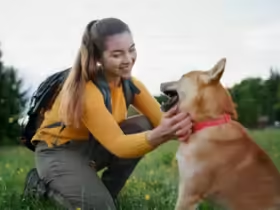Road trips are an exciting way to explore new places, and bringing your pet along for the adventure can make it even more enjoyable. However, traveling with pets requires extra planning and attention to their needs. Whether you’re a first-time road tripper with a pet or an experienced traveler looking to fine-tune your routine, this comprehensive guide will help ensure a safe, comfortable, and fun journey for both you and your furry companion.
Preparing for the Trip: Planning is Key
1. Ensure Your Pet is Fit for Travel
Before embarking on a long road trip, it’s important to assess whether your pet is fit to travel. Some pets, especially older animals or those with health conditions, may struggle with long hours in the car.
- Visit the Veterinarian: Schedule a check-up with your vet to make sure your pet is healthy enough for travel. Ensure vaccinations are up-to-date, and ask your vet for advice on managing anxiety or motion sickness if needed.
- Identification: Make sure your pet has an ID tag with up-to-date contact information. Microchipping your pet adds another layer of security in case they get lost during the trip.
2. Choose Pet-Friendly Accommodations
If your road trip involves overnight stays, make sure you book accommodations that are pet-friendly. Not all hotels or rentals accept pets, and some have restrictions based on the size or number of pets allowed.
- Research in Advance: Websites like BringFido and Airbnb allow you to filter accommodations by pet-friendly options.
- Check Pet Policies: Some hotels may charge extra fees for pets or have specific rules about where pets are allowed on the property. Always read the fine print to avoid surprises.
3. Familiarize Your Pet with Car Travel
If your pet isn’t accustomed to car travel, it’s best to start with short trips before attempting a longer road trip. Gradually increasing the duration of your trips will help them get used to the experience.
- Take Practice Runs: Start with short drives around your neighborhood or to the park. This will help your pet become familiar with the car environment and reduce anxiety during the actual trip.
- Associate the Car with Positive Experiences: Bring their favorite toys or treats to make the car a fun and comforting place for them.
Packing Essentials for Your Pet
Just as you pack for yourself, your pet needs certain items to ensure their comfort and well-being on the road. Here’s a checklist of essential items:
1. Food and Water
Bring enough of your pet’s regular food to last the duration of the trip, as switching foods abruptly can cause digestive issues.
- Portable Food and Water Bowls: Collapsible bowls are convenient for road trips and help reduce space in your car.
- Water Supply: Always carry extra water to keep your pet hydrated, especially on long, hot drives.
- Treats: Pack plenty of treats to reward good behavior and provide comfort during the trip.
2. Leash, Collar, and Harness
These are non-negotiables for bathroom breaks and ensuring your pet stays secure when outside the vehicle.
- Leash and Harness: A sturdy leash and properly fitting harness will keep your pet safe during pit stops. Harnesses provide better control than collars, especially for dogs.
- ID Tags: Make sure your pet’s ID tag is securely attached to their collar with updated contact information.
3. Crate or Pet Carrier
A crate or carrier ensures that your pet is safe and comfortable while you’re driving. It prevents them from distracting you and provides a secure place for them to rest.
- Comfort and Security: Choose a crate or carrier that is large enough for your pet to stand, turn around, and lie down comfortably. Add a soft blanket or familiar bedding to make it cozy.
- Safety First: Secure the crate in the back seat or cargo area to prevent it from moving around during sudden stops.
4. Comfort Items
Pets are more likely to feel at ease if they have familiar items with them.
- Blankets and Bedding: Bring your pet’s favorite blanket or bedding to give them a sense of home.
- Toys and Chews: Bring a few of their favorite toys to keep them entertained. Puzzle toys or long-lasting chews can be great for passing the time.
5. Cleaning Supplies
Accidents happen, especially when your pet is in an unfamiliar environment. Be prepared with the right cleaning supplies.
- Waste Bags: Always have plenty of waste bags on hand for bathroom breaks.
- Towels and Wipes: Bring towels and pet-friendly wipes for any spills, accidents, or muddy paws.
- Litter Box for Cats: If you’re traveling with a cat, bring a portable litter box for easy bathroom breaks.
On the Road: Keeping Your Pet Comfortable and Safe
Once you’re on the road, keeping your pet safe and comfortable becomes your top priority. Here are some tips to make the journey smoother:
1. Safety First: Securing Your Pet
Just like humans, pets should be secured in the vehicle to avoid injury in case of sudden stops or accidents.
- Pet Seat Belts: For dogs, consider a pet seat belt or harness that attaches to the car’s seat belt system. This keeps them secure while allowing them to sit or lie down comfortably.
- Crates and Carriers: As mentioned, always secure crates or carriers in the car. A loose crate can become a hazard in an accident.
- No Lap Riding: Never allow your pet to ride on your lap while driving. This can distract you and increase the risk of an accident.
2. Plan Frequent Breaks
Long road trips can be tiring for your pet, so plan regular breaks to allow them to stretch, relieve themselves, and get some fresh air.
- Pit Stops Every 2-3 Hours: Aim to stop every couple of hours to let your dog out for a short walk. Cats can also benefit from a break to drink water and use the litter box if needed.
- Find Pet-Friendly Rest Areas: Research pet-friendly rest areas along your route. Some rest stops even have designated pet exercise areas where they can burn off some energy.
3. Watch for Motion Sickness
Just like humans, pets can suffer from motion sickness. If your pet is prone to it, talk to your vet about possible solutions, such as medications or natural remedies.
- Limit Food Before Travel: Try to avoid feeding your pet a large meal just before starting the trip. A light meal a few hours before departure can help prevent nausea.
- Provide Fresh Air: Keeping a window slightly open can help with ventilation and reduce the likelihood of motion sickness.
4. Monitor Their Behavior
Keep an eye on your pet’s behavior throughout the journey. Signs of stress, overheating, or discomfort should be addressed immediately.
- Look for Signs of Stress: Panting, whining, pacing, or excessive drooling can indicate that your pet is feeling anxious or uncomfortable.
- Keep the Car Cool: Ensure the car is well-ventilated and never leave your pet in a parked car, even for a short time, as temperatures can rise dangerously fast.
Keeping Your Pet Entertained
Long hours in the car can be boring for pets, so providing mental stimulation is key to keeping them calm and content during the trip.
1. Interactive Toys
Toys that require your pet to work for treats, such as puzzle toys or KONGs filled with peanut butter, can keep them occupied for extended periods.
- Rotate Toys: Bring a few different toys and rotate them throughout the trip to keep things interesting.
2. Frequent Interaction
Talk to your pet throughout the journey and offer plenty of positive reinforcement for good behavior. This helps them feel more secure.
- Reassuring Words: If your pet gets anxious, calmly talking to them can help alleviate some of their stress.
Arriving at Your Destination
Once you’ve reached your destination, there are a few steps to ensure a smooth transition for your pet.
1. Set Up a Safe Space
Create a familiar and comfortable space for your pet to relax once you arrive. This could be a designated area with their bed, toys, and water bowl.
- Introduce New Spaces Gradually: If you’re staying at a hotel or rental, allow your pet to explore the new space at their own pace.
2. Maintain Routine
Try to stick to your pet’s normal feeding, play, and bathroom routine to provide a sense of normalcy, even in a new environment.
- Consistent Mealtimes: Feeding your pet at their usual times helps them adjust to the new setting more easily.
3. Exploring the Area
If you’re in a pet-friendly destination, take the opportunity to explore new sights and smells with your pet.
- Leash Your Pet: Always keep your pet leashed in unfamiliar areas to ensure their safety and prevent them from wandering off.
Conclusion
Road trips with your pet can be an enjoyable and memorable experience if you plan and prepare properly. By taking the time to ensure your pet’s safety, comfort, and happiness, you’ll both have a fantastic journey together. Remember, a well-planned road trip can strengthen the bond between you and your furry friend, turning your adventure into one that neither of you will forget!
By following the tips in this guide, you’ll be well-equipped to handle any challenges that come your way and make your road trip a safe and enjoyable experience for both you and your pet. Happy travels!











Leave a Reply